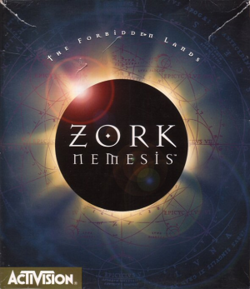This article needs additional citations for verification .(March 2013) |
| Zork Nemesis: The Forbidden Lands | |
|---|---|
 | |
| Developers | Zombie LLC, Activision |
| Publisher | Activision |
| Director | Cecilia Barajas |
| Producer | Cecilia Barajas |
| Designers | Cecilia Barajas Mark Long |
| Programmers | Michael H. Douglas Paul Gallagher Ben Diamand Gary Jesdanun Andrew G. Silber David Chien Mason Deming Edward Clune Ted Huntington Brian Dean Jennings |
| Artists | Mauro Borrelli Scott Goffman Jack Burton |
| Writers | Cecilia Barajas Nick Sagan Adam Simon |
| Composer | Mark Morgan |
| Platforms | Windows 95, MS-DOS, Macintosh |
| Release | PC Macintosh 1996 |
| Genre | Graphic adventure |
| Mode | Single-player |
Zork Nemesis: The Forbidden Lands is a graphic adventure game, developed by Zombie LLC, published by Activision, and released in 1996 for Windows 95, MS-DOS, and Macintosh. It is the eleventh game in the Zork series, and is the first title not to be marketed under the Infocom label. [3] It is the second Zork game by Activision after Return to Zork (1993).
Contents
The story, which is darker and less comical than previous Zork games, focuses on players investigating the sudden disappearance of four prominent figures and their children at the hands of a mysterious being known as the "Nemesis", uncovering a sinister plot during their investigations that they must thwart. The game's live-action cast included Lauren Koslow, W. Morgan Sheppard, Allan Kolman, Stephen Macht, Paul Anthony Stewart, Merle Kennedy, and Bruce Nozick.
The game received favorable reviews, despite some criticism of the puzzles and lack of relevance to the Zork setting, and won the 1996 Spotlight Award for "Best Prerendered Art". [4] The game was later re-released by GOG to be compatible with later Windows editions.
The next game in the series, Zork: Grand Inquisitor , was released in 1997.